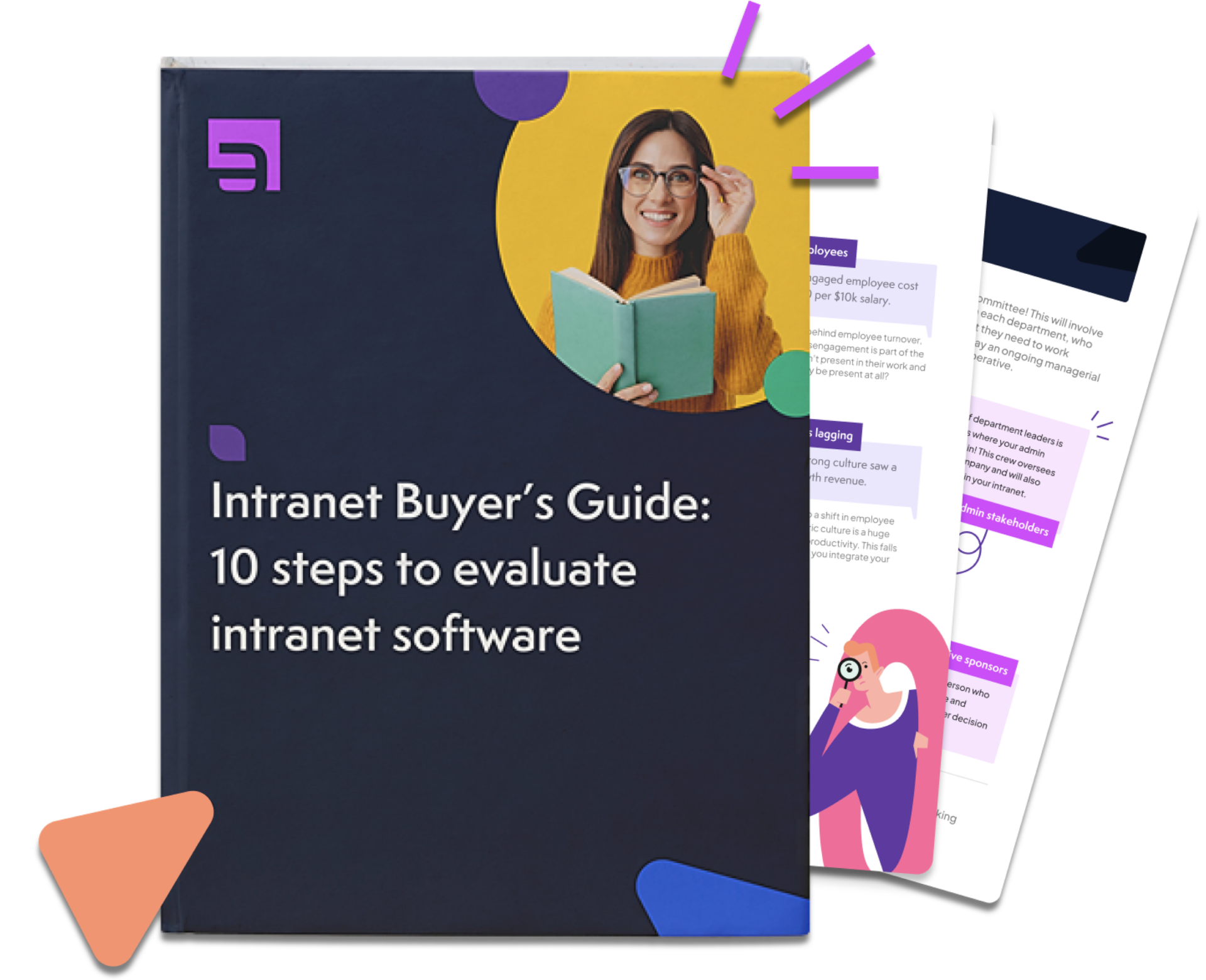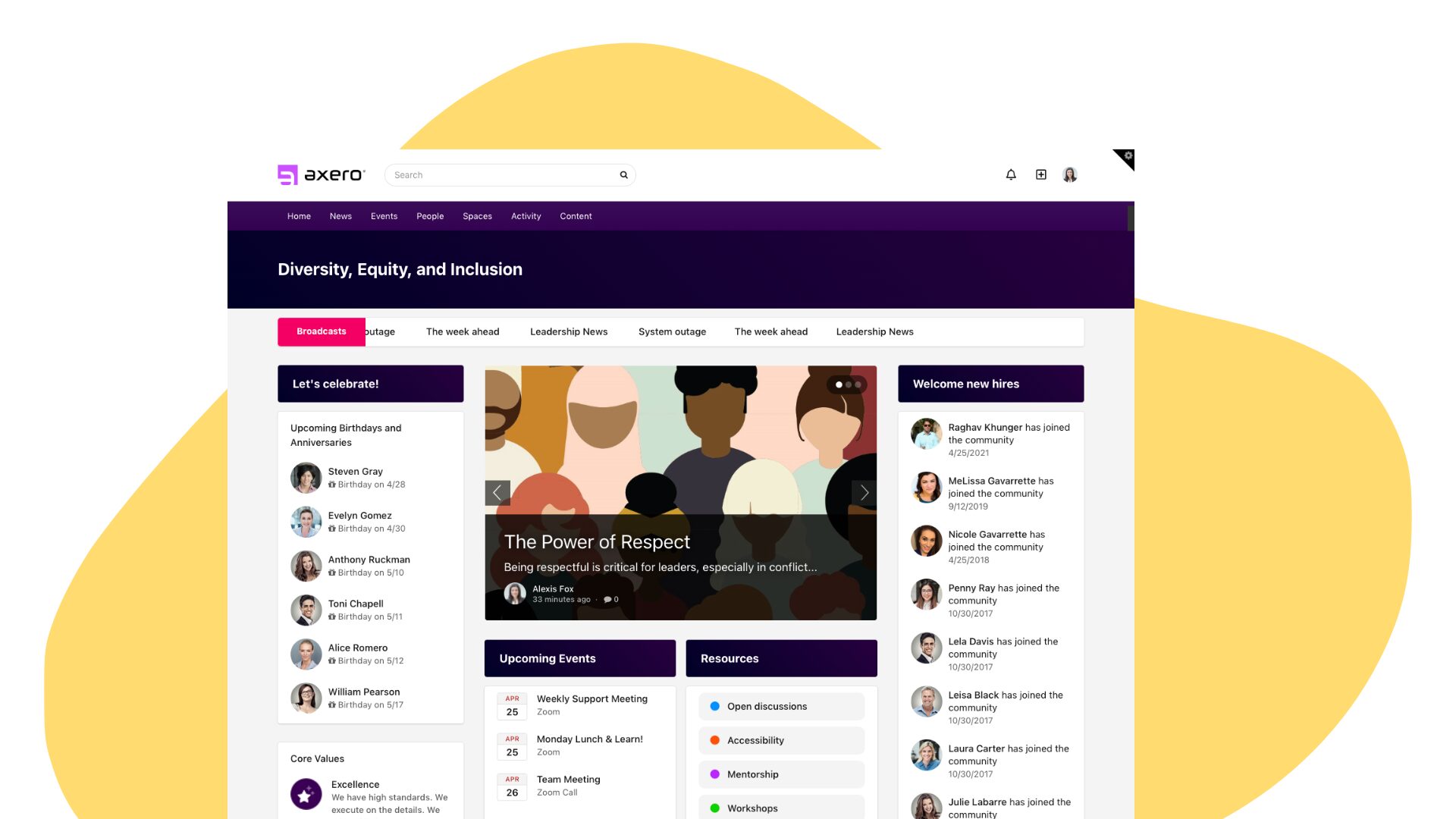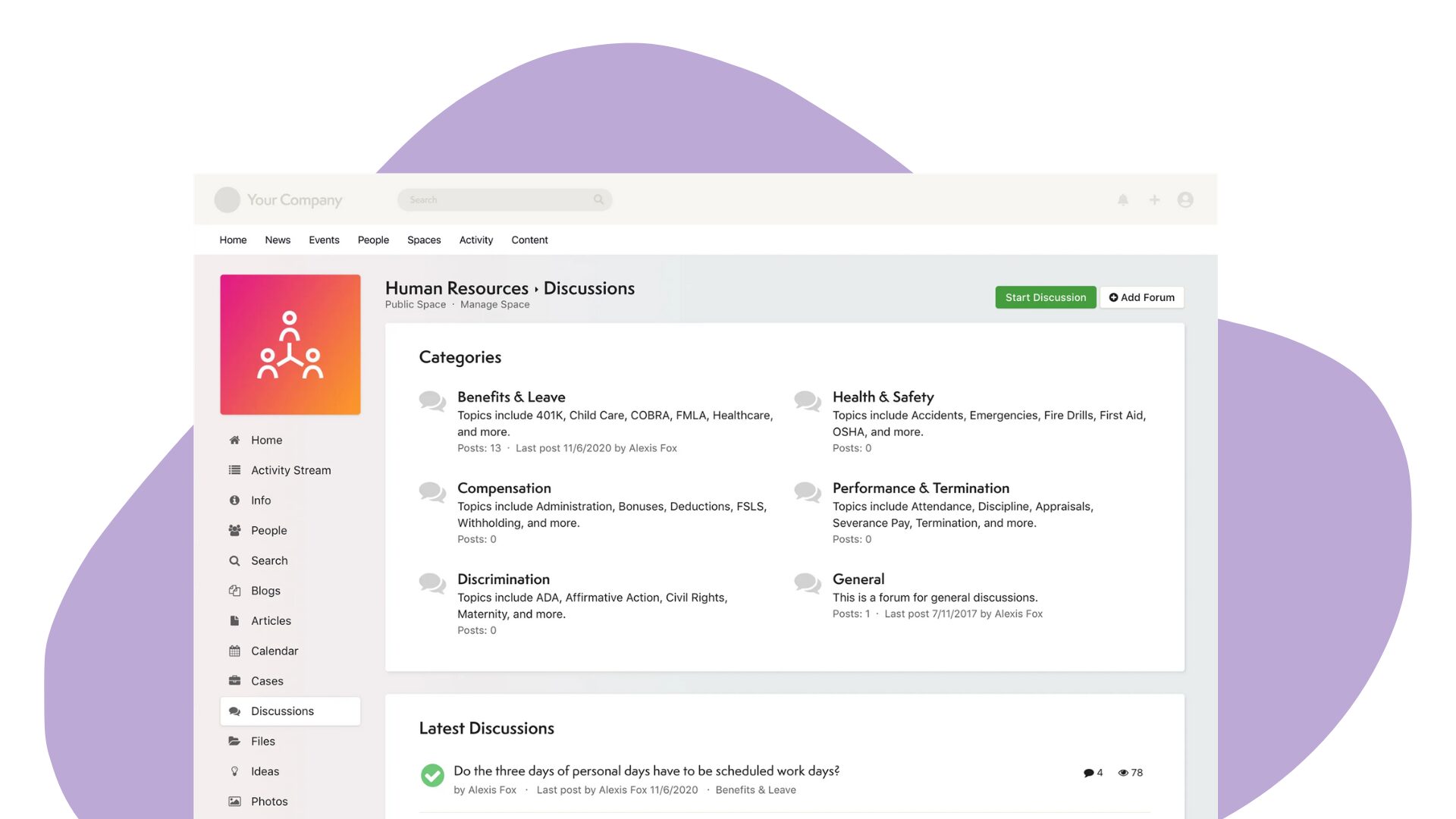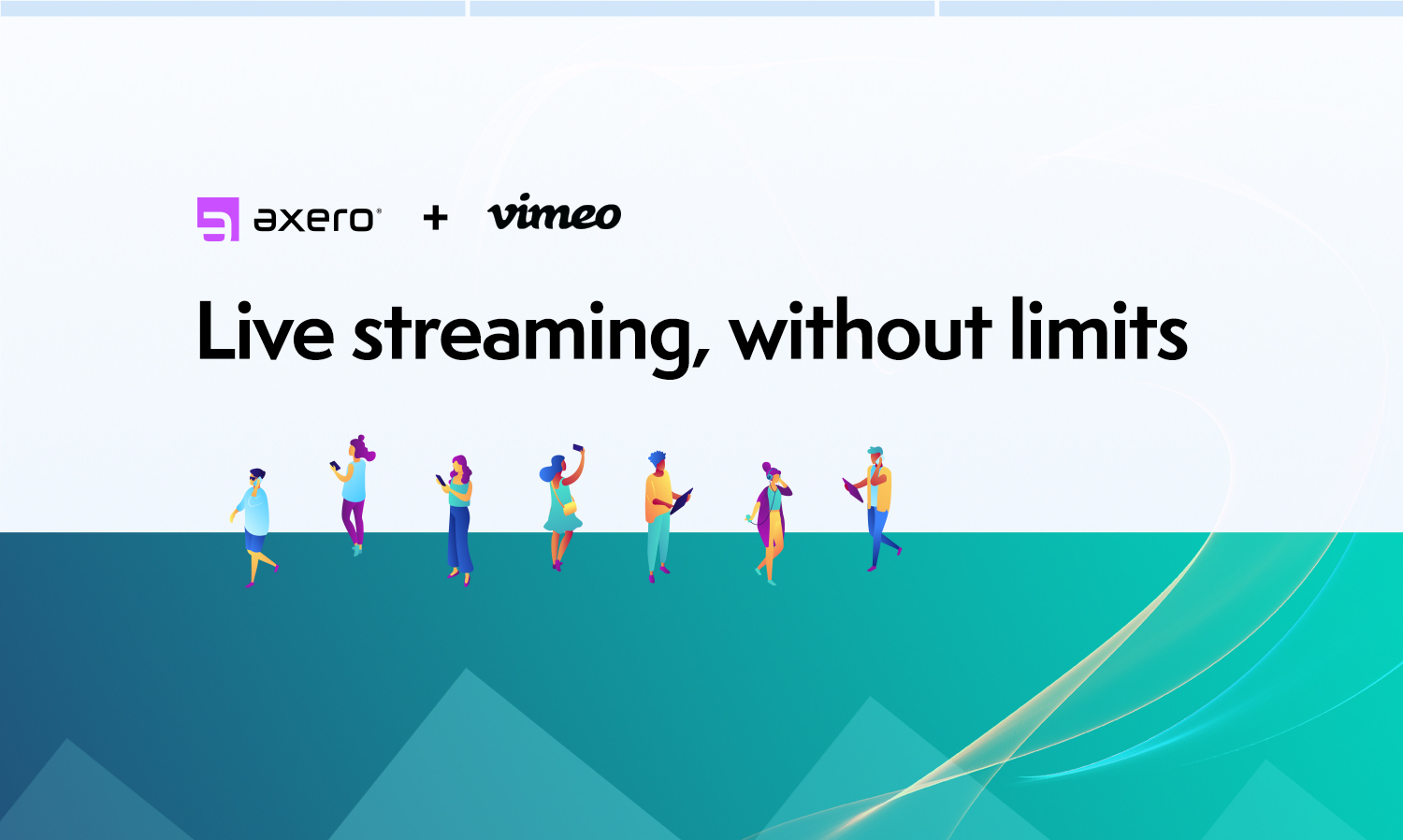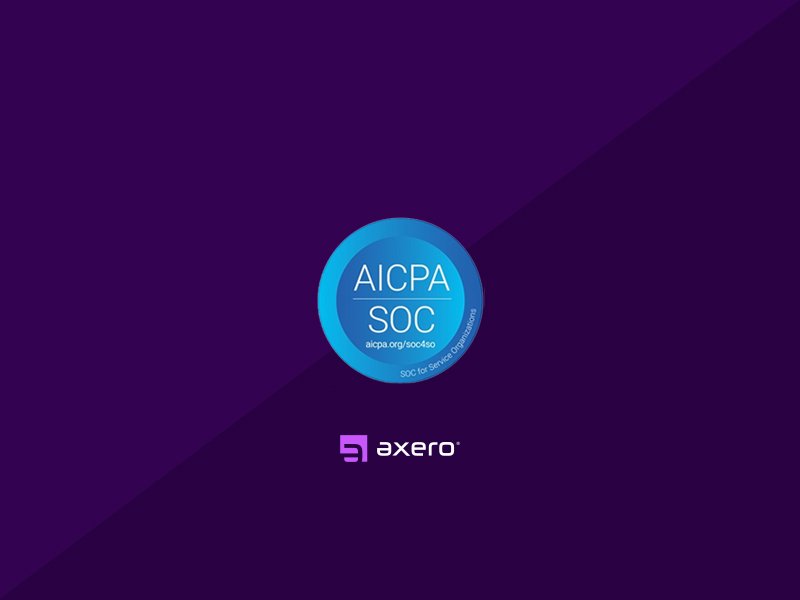We’re happy to announce that Axero 2.5 has been released!
In light of the festivities, we put together this post explaining what you can expect, what’s been changed, and what’s new.
Since there are so many few features and updates for this release, it’s likely that I’ll be updating this post over the next week or so … making sure that I cover everything.
If you want the condensed version … we’ve written up the release notes, which some of you have probably been following. You can check out the release notes here.
Ok … what’s new:
Axero 2.5 is quite a nice release … we’ve been thoroughly enjoying it internally here at Axero … and the communication and collaboration with our employees and customers has just been kicked up a notch.
We like it — and hope you do too.
First, I’ll cover the major changes and improvements, and then at the end of the post I’ll cover the minor features:
Like and Dislike buttons, Nested Comments
You asked, we delivered. You and your members can now “Like” things throughout the platform … ‘like’ a blog post, ‘like’ an article, ‘like’ a stream post, ‘like’ a comment, etc. When you ‘like’ something, it will tally the number of likes and show who liked it. The Like button is always active by default, and we’ve added a setting in the admin that allows you to turn on/off the Dislike buttons. The control for Like and Dislike is very portable too, so if you’ve added your own entities in your Axero deployment you can easily add Like/Dislike to them.
Recently, a ton of requests (almost all within a week) were made for nested comments. So, we added them! You can now have nested comments for all content throughout the platform. Users can reply to a comment using the “reply” button and the comment will be displayed beneath the comment they commented on. Only one-level of nesting is allowed, so you can’t comment on a comment of a comment. We’ve also added Like/Dislike buttons to each of the comments. Furthermore, you can choose to allow your users to rate the comments (this can be configured in the admin settings). And after using the new commenting system internally here at Axero, everyone has expressed how much they like (and how pleasant it is) to comment on things now.
Here a screenshot of the nested comments, like buttons, and rating controls:
New MyAccount layout
A BIG change for the better. Wow! Customers that have seen this have been giving us some really positive feedback regarding this update. We totally redesigned the MyAccount section to provide a more familiar and optimized layout for better usability, faster adoption, better organization of a users content, and more room for scalability and future enhancements. This update is best explained by the screenshot below:
Activity Stream
Another awesome update. We’ve integrated the MyAccount stream with activity from all over the platform. When logged in, a user will now see wall posts and activity from their friends and also from the spaces they are a part of. This takes care of uniting a user and the content that is most important to them. And in an upcoming service release, we’ll give each user some awesome features to filter this stream.
Isolated Spaces
First, if you don’t know what a “Space” is … you can read about them in this post, where we explain what they are and a bunch of ways you can use them. In Axero V2.5, you can create Isolated Spaces that are totally separate from the Community as a whole. When you create an Isolated space, it is sort of like its own separate community, away from the entire community. Further explanation of Isolated spaces is described in our wiki.
Nested Spaces
Axero version 2.5 and above supports the concept of nested groups or spaces. You can create multiple child spaces within any space. For example, assume you are creating a company space named as Company Acme. Now, you want to create “X” child spaces within this Company Acme space.
Only space members who have the “Create Nested Spaces” permission (a space level permission) will be able to create child spaces. To create child spaces, space members can click “Create a nested space” hyperlink from the menu bar available on the space landing page.
All child spaces nested inside a parent space can be either public or private. Public spaces will be visible to outside members only if the parent space is public, and if the parent space is private then such public child spaces will only be visible to members of the parent space.
Each nested space will have its own set of members, roles and permissions. Child spaces will not inherit anything from their parent spaces but they will be accessible from only within their parent space.
All nested spaces will appear under the Communities section which is placed on the right side on the space homepage. This control will show all public child spaces, as well as private & isolated spaces belonging to the logged-in user. If the logged-in user is not a member of any of the child private/isolated spaces, then the control will only show the public child spaces.
MetaWeblog API
Ok? What is this? — The MetaWeblog API is an application programming interface (API) that enables blog entries to be written, edited, and deleted using web services. This gives you and your users the power to do offline blog & article publishing to Axero … through any MetaWeblog API enabled clients, like Microsoft Word, Windows Live Writer, MarsEdit (for the Mac), etc. This request came through our good friends over at the BI Developer Network (https://www.bidn.com), a bunch of computer geeks (like us), that blog frequently about Business Intelligence and SQL Server related topics. After using this feature for a few days, I am so happy they came to us with this request. (I’m writing this post from the San Diego airport using MarsEdit.)
Other enhancements and features
REST API
We’ve been extremely hard at work on the REST API layer, extending it to cover Users, Articles, Blogs, Forums, Events, Photos, Videos, Wikis and Spaces. And we’ll continue to extend the REST layer so you can tie into it and create plugins, other useful apps, and access the data from your Axero deployment in your own applications. And remember, if you’ve created a plugin or somehow extended Axero for your own orgainzation, we’ve love to hear about what you’ve done and your experiences.
Axero Payment Providers
A new project has added to attach payment gateways to the Axero ecommerce store section. By default, Axero comes with two payment providers configured and set up 1) Authorize.NET and 2) CyberSource. You can easily create and attach a custom payment provider without the need to modify the core source code by using the Provider design patterns. Source code for Axero.PaymentProviders project is available on request at no extra cost.
Time Format
Time formatting has been added in the admin settings to specify the time format display settings (like 12 hour or 24 hour formats) globally throughout the community. The setting is also added in the user profile so that users can override the admin settings.
Disable Space Wall Post Notifications
A new setting has been added in the space admin section that allows you to turn ON/OFF the space wall post email notifications.
Rating Control
We’ve created a much more robust, scalable, and portable AJAX/jQuery custom rating control — it’s been added to all content entities, making it much easier for users to rate content, comments, and more. Also included are average rating and total number of votes.
Activity Stream layout
The user interface for the Activity Streams has been “tightened up” for better usability, adoption, and familiarity.
Calendar Events
Quickly add meetings and events to the calendar. You can now add calendar events by clicking a time slot (in the daily or week view) and also by clicking on a day (in the month view).
Surveys
We added functionality to the Polls section for creating multiple question surveys. Create and publish online surveys in minutes, and view results graphically and in real time. Use the surveys to get customer insights, employee fedback, research, planning events, education & training, and more.
Events UI
We redesigned the events User Interface to be much more comprehensive and give your users a total picture of all events and more information pertaining to each Event.
Profile & Avatar Upload
User Experience is always a high priority when we create new features in Axero. And having a uniform user interface is key in the overall experience. Believe it or not, a big part in keeping things uniform is the size and shape of user profile photos and avatars. We’ve added a new photo cropping tool when users upload a profile or avatar photo … this way, every users profile photo and avatar are the same size. (A very cool, but sometimes overlooked feature.)
Contact us form settings
Provide settings page for configuration of the contact us form. When submitted, the info can be sent to an email address that is provided in the CFAppSettings.config file.
eCommerce Payment Providers
We’ve added a new project so your developers can attach payment gateways to the Axero store section. By default, Axero comes with two payment providers configured: Authorize.Net and CyberSource. You can easily create and attach a custom payment provider by using the Provider design pattern, without the need to modify the core source code. The source code for the Axero.PaymentProviders project is available on request at no extra cost.
width=”660″>
We’re happy to announce that Axero 2.5 has been released!
In light of the festivities, we put together this post explaining what you can expect, what’s been changed, and what’s new.
Since there are so many few features and updates for this release, it’s likely that I’ll be updating this post over the next week or so … making sure that I cover everything.
If you want the condensed version … we’ve written up the release notes, which some of you have probably been following. You can check out the release notes here.
Ok … what’s new:
Axero 2.5 is quite a nice release … we’ve been thoroughly enjoying it internally here at Axero … and the communication and collaboration with our employees and customers has just been kicked up a notch.
We like it — and hope you do too.
First, I’ll cover the major changes and improvements, and then at the end of the post I’ll cover the minor features:
Like and Dislike buttons, Nested Comments
You asked, we delivered. You and your members can now “Like” things throughout the platform … ‘like’ a blog post, ‘like’ an article, ‘like’ a stream post, ‘like’ a comment, etc. When you ‘like’ something, it will tally the number of likes and show who liked it. The Like button is always active by default, and we’ve added a setting in the admin that allows you to turn on/off the Dislike buttons. The control for Like and Dislike is very portable too, so if you’ve added your own entities in your Axero deployment you can easily add Like/Dislike to them.
Recently, a ton of requests (almost all within a week) were made for nested comments. So, we added them! You can now have nested comments for all content throughout the platform. Users can reply to a comment using the “reply” button and the comment will be displayed beneath the comment they commented on. Only one-level of nesting is allowed, so you can’t comment on a comment of a comment. We’ve also added Like/Dislike buttons to each of the comments. Furthermore, you can choose to allow your users to rate the comments (this can be configured in the admin settings). And after using the new commenting system internally here at Axero, everyone has expressed how much they like (and how pleasant it is) to comment on things now.
Here a screenshot of the nested comments, like buttons, and rating controls:
New MyAccount layout
A BIG change for the better. Wow! Customers that have seen this have been giving us some really positive feedback regarding this update. We totally redesigned the MyAccount section to provide a more familiar and optimized layout for better usability, faster adoption, better organization of a users content, and more room for scalability and future enhancements. This update is best explained by the screenshot below:
Activity Stream
Another awesome update. We’ve integrated the MyAccount stream with activity from all over the platform. When logged in, a user will now see wall posts and activity from their friends and also from the spaces they are a part of. This takes care of uniting a user and the content that is most important to them. And in an upcoming service release, we’ll give each user some awesome features to filter this stream.
Isolated Spaces
First, if you don’t know what a “Space” is … you can read about them in this post, where we explain what they are and a bunch of ways you can use them. In Axero V2.5, you can create Isolated Spaces that are totally separate from the Community as a whole. When you create an Isolated space, it is sort of like its own separate community, away from the entire community. Further explanation of Isolated spaces is described in our wiki.
Nested Spaces
Axero version 2.5 and above supports the concept of nested groups or spaces. You can create multiple child spaces within any space. For example, assume you are creating a company space named as Company Acme. Now, you want to create “X” child spaces within this Company Acme space as follows:
- Top Level Community
- Company Acme Space (Space 1)
- Human Resources: Private Space (sub-space)
- Accounts & Finance: Private space (sub-space)
- Public Relations: Public space (sub-space)
- Company Acme Space (Space 2)
-
- Human Resources: Private Space (sub-space)
- Accounts & Finance: Private space (sub-space)
- Public Relations: Public space (sub-space)
- Company Acme Space (Space 1)
Only space members who have the “Create Nested Spaces” permission (a space level permission) will be able to create child spaces. To create child spaces, space members can click “Create a nested space” hyperlink from the menu bar available on the space landing page.
All child spaces nested inside a parent space can be either public or private. Public spaces will be visible to outside members only if the parent space is public, and if the parent space is private then such public child spaces will only be visible to members of the parent space.
Each nested space will have its own set of members, roles and permissions. Child spaces will not inherit anything from their parent spaces but they will be accessible from only within their parent space.
All nested spaces will appear under the Communities section which is placed on the right side on the space homepage. This control will show all public child spaces, as well as private & isolated spaces belonging to the logged-in user. If the logged-in user is not a member of any of the child private/isolated spaces, then the control will only show the public child spaces.
MetaWeblog API
Ok? What is this? — The MetaWeblog API is an application programming interface (API) that enables blog entries to be written, edited, and deleted using web services. This gives you and your users the power to do offline blog & article publishing to Axero … through any MetaWeblog API enabled clients, like Microsoft Word, Windows Live Writer, MarsEdit (for the Mac), etc. This request came through our good friends over at the BI Developer Network (https://www.bidn.com), a bunch of computer geeks (like us), that blog frequently about Business Intelligence and SQL Server related topics. After using this feature for a few days, I am so happy they came to us with this request. (I’m writing this post from the San Diego airport using MarsEdit.)
Other enhancements and features
REST API
We’ve been extremely hard at work on the REST API layer, extending it to cover Users, Articles, Blogs, Forums, Events, Photos, Videos, Wikis and Spaces. And we’ll continue to extend the REST layer so you can tie into it and create plugins, other useful apps, and access the data from your Axero deployment in your own applications. And remember, if you’ve created a plugin or somehow extended Axero for your own orgainzation, we’ve love to hear about what you’ve done and your experiences.
Axero Payment Providers
A new project has added to attach payment gateways to the Axero ecommerce store section. By default, Axero comes with two payment providers configured and set up 1) Authorize.NET and 2) CyberSource. You can easily create and attach a custom payment provider without the need to modify the core source code by using the Provider design patterns. Source code for Axero.PaymentProviders project is available on request at no extra cost.
Time Format
Time formatting has been added in the admin settings to specify the time format display settings (like 12 hour or 24 hour formats) globally throughout the community. The setting is also added in the user profile so that users can override the admin settings.
Disable Space Wall Post Notifications
A new setting has been added in the space admin section that allows you to turn ON/OFF the space wall post email notifications.
Rating Control
We’ve created a much more robust, scalable, and portable AJAX/jQuery custom rating control — it’s been added to all content entities, making it much easier for users to rate content, comments, and more. Also included are average rating and total number of votes.
Activity Stream layout
The user interface for the Activity Streams has been “tightened up” for better usability, adoption, and familiarity.
Calendar Events
Quickly add meetings and events to the calendar. You can now add calendar events by clicking a time slot (in the daily or week view) and also by clicking on a day (in the month view).
Surveys
We added functionality to the Polls section for creating multiple question surveys. Create and publish online surveys in minutes, and view results graphically and in real time. Use the surveys to get customer insights, employee fedback, research, planning events, education & training, and more.
Events UI
We redesigned the events User Interface to be much more comprehensive and give your users a total picture of all events and more information pertaining to each Event.
Profile & Avatar Upload
User Experience is always a high priority when we create new features in Axero. And having a uniform user interface is key in the overall experience. Believe it or not, a big part in keeping things uniform is the size and shape of user profile photos and avatars. We’ve added a new photo cropping tool when users upload a profile or avatar photo … this way, every users profile photo and avatar are the same size. (A very cool, but sometimes overlooked feature.)
Contact us form settings
Provide settings page for configuration of the contact us form. When submitted, the info can be sent to an email address that is provided in the CFAppSettings.config file.
eCommerce Payment Providers
We’ve added a new project so your developers can attach payment gateways to the Axero store section. By default, Axero comes with two payment providers configured: Authorize.Net and CyberSource. You can easily create and attach a custom payment provider by using the Provider design pattern, without the need to modify the core source code. The source code for the Axero.PaymentProviders project is available on request at no extra cost.
